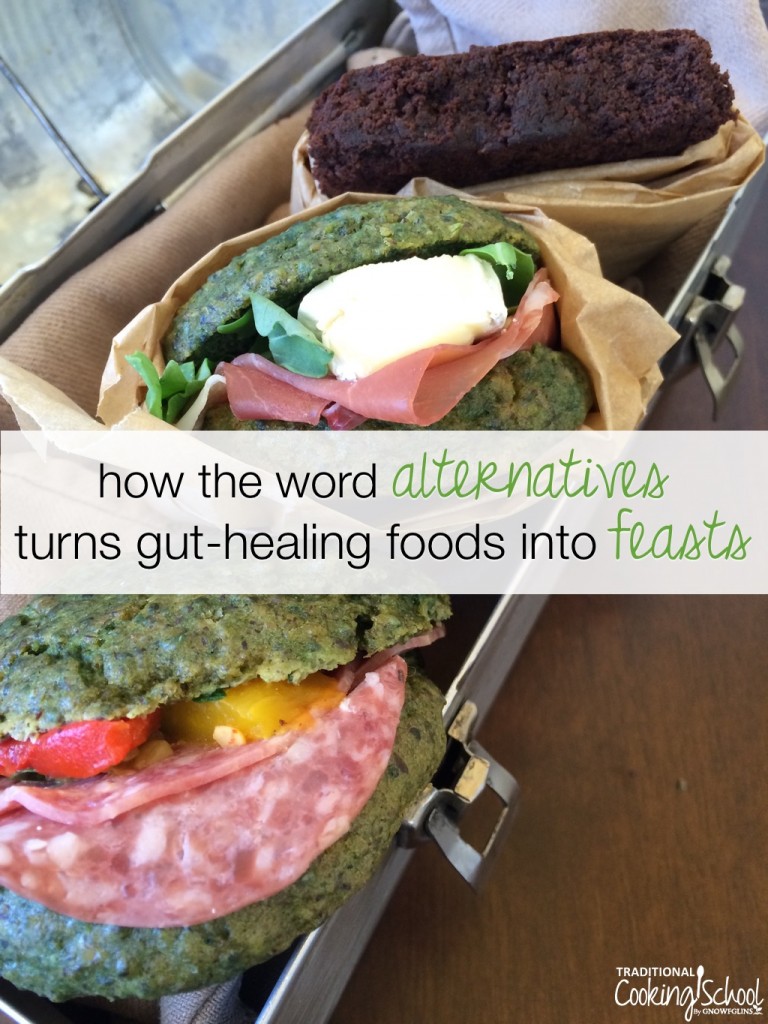
Yesterday, you met my in-real-life friend Megan. We got together for a video chat and talked about how by the age of 40, she’d been diagnosed with 5 serious health conditions (and her children had health issues, too) and how following a gut-healing diet turned their health around completely.
That was part 1. Today is part 2, and it’s all about the foods!
Megan and her family have been on a gut-healing diet for more than 4 years. Not only have they experiencing healing, they’ve loved their foods. No one’s choking down blah, dry, and repetitive meals. I know this for a fact because I’ve eaten in their home and cafe; no one leaves the table feeling any lack. It’s amazing.
The idea behind this feasting is actually Megan’s favorite word — “alternatives”. It’s the most important word for anyone who wants to thrive on a gut-healing diet. You’ll hear all about it in the video below.
Also in the video, Megan brought lunch. 🙂 Oh, my, I wish I could eat it all over again! She shared panini sandwiches — the same ones they serve in their Paleo gut-friendly cafe, Vanilla Jill’s, in Eugene, Oregon — and grain-free, refined-sweetener-free brownies.
You’ll get to hear about the recipes and see the beautiful foods in today’s video! Prepare to drool. 🙂 The video and transcript are included below.
Interested in Megan’s feast-worthy recipes and techniques?
Good news. Megan released her brand-new eCookbook yesterday — Eat Beautiful: Grain-Free, Sugar-Free and Loving It (softcover version as well).
It contains all the recipes she’s perfected through her family’s years on a gut-healing diet. It’s truly amazing. I am a close friend, yes, but I can honestly say no love clouds my judgment on this pronouncement!
She put together an eBook and video package for you at 50% off.
One of the bonus videos you’ll get explains the grain-free baking technique that’s used to make the amazing panini sandwiches you’re about to see.
Enjoy!
<begin transcript>
Wardee Harmon: Hi Everyone, I’m Wardee with Traditional Cooking School and I’m back again with my friend Megan. Hi, Megan.
Megan Stevens: Hi.
Wardee: We are talking about Megan’s brand new cookbook Eat Beautiful: Grain-Free, Sugar-Free and Loving It — and today is all about the food.
In our last video we talked about Megan’s health story so you’ll want to be sure to watch that. I’ll have a link for you below this video or you can click right on this video to go right to it.
Right now we’re going to talk all about the food.
We have this wonderful grain-free, sugar-free lunch to sample. And we’re going to show you it.
Before we dive into this feast I want to tell you about Megan’s, well Megan is going to tell you about Megan’s, favorite word. It’s called: Alternatives.
It’s a very important word in Megan’s family and with their gut healing diet that they thrive on and they love. The book is aptly titled in that it ends with loving it. And they do love it. Alternatives is a key part of that.
So tell us about alternatives.
Megan: Sure. So I think when you start any healing diet you’re going to feel deprivation. Whether it’s your body coming off of a sugar addition or just missing your old favorites.
Alternatives come into play immediately because you need them. You need treats. You can’t expect to go into a state of deprivation and expect yourself to flourish.
Most of us can’t take time off work, or from the important things that need to be done, to just lay in bed all day and languish. So we need alternatives so we can stay happy.
So we can enjoy our diet and hopefully be on it for years if necessary.
I know that sounds difficult. Many people do not want to be on a healing diet for years. But the reason we succeeded is because of these alternatives.
What that means is if you used to love a cinnamon roll at your favorite bakery, you create a cinnamon roll or find one that you love that is not just a grain-free substitute but that it is genuinely easy to digest. So when you eat it you are eating it without guilt.
For us, in our family, that started with the easiest recipes like pancakes and muffins. When we’d be eating a bowl of that healing soup, we would have – to the side of it—a scone or a muffin. Or at breakfast time with our bone broth soup we’d have pancakes. You can imagine for kids that is a deal maker. That is what made the GAPS diet successful for our family.
But even grownups. We’ve had addictions longer than the kids! So we really need those treats.
Alternatives they provide a healthy way of succeeding on a diet by still allowing yourself to have treats. Foods that taste literally scrumptious when you eat them. Instead of just being a stand-in and you can’t wait, or you wish, you could get back to what you used to love.
Wardee: Which is so important. I think you said it already. There’s this feeling when you go on a restricted diet that you are being deprived of things that you love. So if you can pursue these alternatives and come up with delicious tasting, but healthy, and those comfort foods.
The ones that you are not just eating it but it’s the emotion rush and the memories it brings back. The feelings of being in that favorite café. Or remembering when you were 10 years old and your grandma bringing you that plate of cookies or whatever. It’s that whole eating experience and that’s why alternatives is so important to our healing.
Megan: Yes. And I would just add to that. There were many weekends I would go with my family to a bakery and we would get a cup of coffee and whatever baked good we really enjoyed. But I will say that probably none of those experiences ever satisfied me. I always wanted more room in my belly or for the cinnamon roll to be bigger or I was waiting for when I could have chocolate again.
I think that is makes the alternatives additionally superior. Is that when you eat them, you actually feel satiated. And so they make you feel happy in every way instead of it being like an addiction you have to return to.
Wardee: Great point.
So it’s time to dive in. So, Megan. Show us!
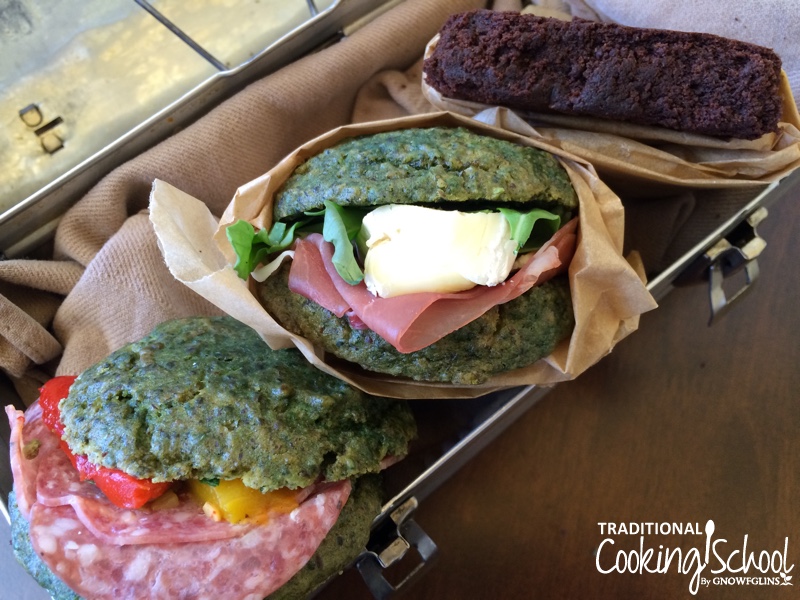
Megan: All right. These are basically like Panini sandwiches.
Wardee: Ooooo. I love Panini sandwiches. Ahhh.
Megan: These are make on sprouted sunflower seed Panini bread. There are three different kinds.
This is one of my favorites, called the Muffaletta. It has Applegate Farm salami, homemade olive tapenade and roasted peppers.
Wardee: And these are sandwiches you sell in your café, right?
Megan: We do. Yeah. And this bread is so popular that we’ve had ton of customer requests for the recipe. So I keep saying the cookbook is almost out then you can have the recipe!
This particular variety of the Panini is made with kale.
Wardee: The Panini you mean is the bread?
Megan: The bread. Exactly. So we have two versions of this recipe. One is a traditional blond looking bread, pale in color. Then there is this recipe with the kale which is why the bread is green.
We have the Muffaletta, then we have one with prosciutto, brie and arugula – which is my favorite right now. The Muffaletta used to be my favorite then of course I ate about a hundred of them! And now the prosciutto is my new favorite.
Prosciutto is nice because it’s just Italian pork and salt so it’s safe for most healing diets.
Then this one is smoked salmon with cultured cream cheese, capers, thinly sliced cucumber and lettuce.
Wardee: Beautiful. So I’d love you to talk a little bit about the bread.
Megan: Sure!
Wardee: You mentioned it’s very popular with your customers and people are wanting the recipe. It is really special because you use a really special technique. So tell us about that.
Megan: Sure. Sure. So the baking technique originally came from Dr. Natasha Campbell-McBride in her cookbook. She had one recipe that was really in my mind and my daughter’s mind that kind of set it apart for texture.
We were playing a lot with almond flour and almond meal and coconut flour like most people who go on a grain free diets. We were only moderately happy with those textures.
And so what she did is she took a soaked nut and instead of dehydrating it she used it while it was still wet and pureed it into a batter. So you have something there right off the bat that’s going to be moister than a nut that is dehydrated.
Then I’ve spent the last three years developing this concept into scones and all kinds of different recipes. Basically with recipe you are able to emulate a yeast texture. It’s very similar to a yeast bread. However it’s a batter bread. And that’s all due to the technique that she introduced to me and that I’ve really enjoyed developing. People eat this at the café and their like “how did you make this bread?” And that’s it. It’s using the technique.
Wardee: Wonderful.
Megan: Yeah. And that is still sprouted.
Wardee: So, the results are better because your bread is so moist. It is also better for you. It’s better for digestion because of the soaking.
Megan: Yes. And I would say another benefit is that it’s so easy. That’s one of the reasons people love coconut flour and almond meal because you can just buy it and use them. With this method you simply soak them overnight, rinse them off and in the morning they are ready. You throw everything in the blender and puree it. It’s really fast, low maintenance and way more digestible than store bought almond flour for instance. So I’m a big fan for multiple reasons.
Wardee: Okay. I’m going to taste.
Megan: Great!
Wardee: Which one should I try?
Megan: Do the Muffaletta.
Wardee: Okay.
I have enjoyed Megan’s cooking many times. It’s always wonderful. So this is the one with Applegate?
Megan: Yes. And the bread with these sandwiches is very versatile. We do roasted chicken on them. We do lamb with Israeli feta and tzatziki sauce. So they are really flexible for whatever you want in a sandwich.
Wardee: Wow. This is fabulous.
Megan: Thank you. Good.
Wardee: I’m going to take another bite and then we’re going to talk about the treats. This is a treat though.
Megan: Yeah, it’s fun to put really rich fillings inside. High flavor, high fat and then sometimes some greens. There are lots of good marinated flavors going on.
Wardee: Thank you. This is amazing.
Megan: Good, good. I’m so glad.
Wardee: I’ll save the rest for lunch. Okay so, what else do you have?
Megan: I brought some brownies. One of the things about a brownie is it really requires a lot of sugar. That’s what makes a good brownie. You look at traditional food, not traditional as in Weston A. Price but Standard American Diet, look at brownies…
Wardee: Brownies are very sweet.
Megan: Yeah, exactly. And they rely on a high amount of sugar to get their texture. A cup and a half or two cups of sugar. One thing I’ve done with this recipe is I used three kinds of sweetener. I love honey but it has a really strong flavor. You really don’t really want that to overwhelm the cocoa flavor or the gooeyness of what you want the brownie to be.
Wardee: You want a neutral sweet.
Megan: Exactly. Exactly. And I love maple syrup but again, it’s got its own distinct flavor. So with this brownie I actually used three sweeteners: local raw honey, pure maple syrup and coconut sugar. The coconut sugar, having that granulated sugar, is important. It offers its own unique quality.
This is a nice brownie. It’s a little bit gooey, a little bit cakey, a little bit dense and fudgy. So I tried to capture all of those things; the really texture that all of us want in a brownie. It’s not as gooey as falling through your fingers but it’s really a nice texture because of those three sweeteners. It is nut-free. So, yeah.
Wardee: Well these look wonderful so I don’t want to wait even another second.
Megan: (laughs) Great.
Wardee: They look like they have a great brownie texture; moist and dense.
Megan: Yeah, it’s nice.
Wardee: Mmmmm. Wow!
Megan: Great!
Wardee: You’ve done it! This will satisfy…
Megan: Nice
Wardee: …the biggest sweet tooth. My addiction is cured also but I still love sweets.
Megan: Let’s face it. We love sweets. That’s how I feel about chocolate, too. There’s nothing like it.
Wardee: It’s great to get to the point where you’re not craving sweets, you don’t have the afternoon crash and you cannot go another minute without having something sweet. So to get over that is amazing.
Still to be able to heal your gut and enjoy nourishing food and have the sweet for the enjoyment — not the craving is wonderful.
Megan: Yeah, that is so well put. And I will also say because I’ve been in the process for so long. I meet with people and try to counsel them for healing, the transition period is very important. Like we were talking about alternatives earlier. In the beginning they are still in that process of getting to have no strong addiction anymore. Having a bite of a brownie like that makes the process easier.
Wardee: Right. Because making, going to a gut healing diet can be restricting and that can take a mental toll and an emotional toll. So to not feel deprived during that crucial time and to still have some small victories and still be enjoying the path — is so important.
Megan: And I would say one more thing about the brownie recipe, for instance, or any of the recipes in this book. And that was that my hope was even a gourmet cook, who was not on a healing diet, who simply wanted a maple syrup sweetened brownie. Because on-line there is just a lot of recipes with sugar. I wanted to provide a cookbook with healthier alternatives for anybody and everybody. So I’m hoping these recipes also can meet that need.
Wardee: Good point.
Megan: Yeah.
Wardee: So for more recipes like this, these are a hit in Megan’s café in Eugene, Oregon, but you can have them at home also because she’s put her years’ worth of developing them into her new cookbook Eat Beautiful: Grain-Free, Sugar-Free and Loving It.
You can check it out at TraditionalCookingSchool.com/Megan.
Megan’s put together a package including five videos and one of those videos explains this grain-free baking technique that makes this wonderful bread. It’s a huge asset to that collection, to her eBook package.
Thanks, Megan.
Megan: Thank you, Wardee.
<end transcript>
I Finally Have a Gut-Healing Cookbook To Recommend
I couldn’t be more thrilled to share Megan’s eCookbook with you. You might notice on the cover image that I wrote the foreword (such an honor). All these years that I’ve been talking about gut-healing diets, I didn’t really have an awesome cookbook to recommend.
Now I do. This is it.
It’s currently 50% off, and comes with 5 bonus videos with extra recipes and an introduction to the brand-new grain-free baking technique that ALONE is worth buying the eCookbook.
Click here for more info about the special eCookbook package.
(Softcover version as well. Just so you know, this doesn’t include all 5 bonus videos.)
As you turn the pages and try the recipes in Eat Beautiful, I know you will feel and experience the same thing I did when I first met Megan: hope. Hope that your healing journey will end someday, and that along the way, the food you eat will deeply nourish your body, as well as thrill your soul (and your tastebuds) with its beauty.
What word or concept helps you thrive on a gut-healing diet? What are your favorite foods to feast on? What foods keep you happy while you’re committed to a gut-healing diet?
Thanks for joining me today! Be sure to come back Friday when Megan is a guest on my podcast and we do a whole lot more talking. 🙂
We only recommend products and services we wholeheartedly endorse. This post may contain special links through which we earn a small commission if you make a purchase (though your price is the same).

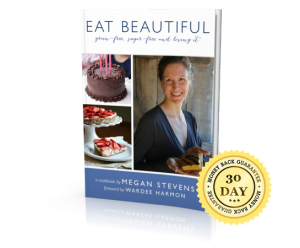
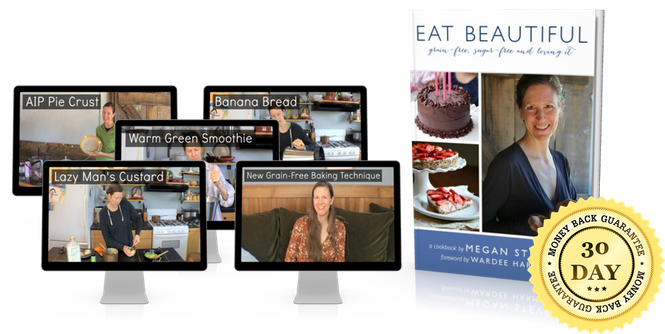
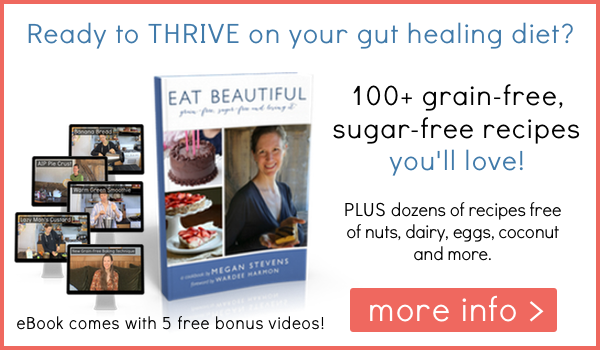

Thank you for introducing us to your dear friend Wardeh. This is a blessing for the issues we are dealing with in our home right now. I purchased the ebook and am excited to bake my way through it. I have a question…..I made the rolls in the video without the kale. Oh my are they good! My question is the next day the remaining rolls were turning green??? They were not moldy just green and today they are a blue/green color? They taste great but it messes with your mind eating a blue/green sandwich. Any ideas how to store them so they do not change color. I kept them in the frig since it is hot and humid where we live. We do not have a problem eating them at home but I would feel funny serving them to guests. Thank you. The cookbook is the best grain free cookbook I have seen!
Hi Donna! I’m so sorry that I didn’t see your question until now. I’m happy to help; and I’m so glad you’re enjoying the recipes!! The reason the rolls turn green is because of something called chlorogenic acid, which is found in sunflower seeds. It is not found in any other nuts or seeds. When chlorogenic acid hits baking soda the reaction causes the green to come out. There are three ways to get around this: 1) Use the kale version so you can just tell your guests, who may not be interested in the science behind it, that the rolls contain kale. 2) Use any other nut or seed. I love to use walnuts, pine nuts and even Brazil nuts. Each add their own unique quality. One of the reasons we still love using sunflower seeds is that they are economical. They also taste great and lend a nice texture. But any nut will work. 3) Omit the baking soda. Baked goods with sunflower seeds, but no baking soda, will not turn green. 🙂
Thank you Megan! Your eBook has been a huge blessing for our family! I had switched to using walnuts, but they are so much more expensive. I will try the sunflower seeds again without the baking soda and see how that goes….. Thank you for sharing your God given culinary creativity with us! Every recipe I have made so far has won me brownie points with the family. :o). Now to figure out how to travel 2,000 miles so we can experience Vanilla Jill’s…….
Do most of the recipes contain egg? I have an egg white allergy and so many of the books I have bought on line that use coconut and almond flours also use eggs.
There are 40+ recipes without egg and about a dozen or more that use yolks only. That said most of the bread type recipes do rely heavily on eggs. I also solved the green problem by using walnuts instead of the sunflower seeds. Looks more like bread.